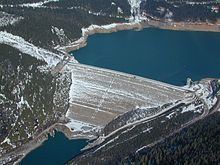Opening date 29 March 1973 Height 240 m Surface area 430 km² | Commission date 1976–1977 Opened 29 March 1973 Province British Columbia | |
 | ||
Total capacity 24.762 km (20,075,000 acre·ft) Similar | ||
Mica Dam, a hydroelectric dam spanning the Columbia River 135 kilometres north of Revelstoke, British Columbia, Canada, was built as one of three Canadian projects under the terms of the 1964 Columbia River Treaty and is operated by BC Hydro. Completed in 1973 under the terms of the treaty, the Mica powerhouse had an original generating capacity of 1,805 megawatts (MW). Mica Dam, named after the nearby settlement of Mica Creek and its associated stream, in turn named after the abundance of mica minerals in the area, is one of the largest earthfill dams in the world. The reservoir for the dam is Kinbasket Lake, which was created when the dam was built. Water from the dam flows south directly into Revelstoke Lake, the reservoir for the Revelstoke Dam. Mica Dam is the tallest dam in Northern America and second tallest in North America after the Chicoasén Dam in Mexico and it is the farthest upstream dam on the Columbia River.. The dam's underground powerhouse was the second largest in the world at the time of its construction, and was the first 500 kV installation of sulphur hexafluoride (SF6) insulated switchgear in the world.
Contents
Map of Mica Dam, Columbia-Shuswap B, BC, Canada
History
Mica Dam was operational on March 29, 1973. The dam was built to a height of 244 metres (801 ft) above bedrock, near the first location of the village Mica Creek. At the time, the dam was one of three storage dams built by the provincial power company BC Hydro, within the description of the Columbia River Treaty. The dam operated with a 427-square-kilometre (165 sq mi) reservoir containing 15 cubic kilometres (12,000,000 acre·ft) of live storage and 24.8 cubic kilometres (20,100,000 acre·ft) of total storage in McNaughton Lake, later renamed Kinbasket Lake in 1980.
The underground powerhouse, begun in 1973, was built to be 54 metres (177 ft) high, 24 metres (79 ft) wide and 237 metres (778 ft) long. In 1976, the first two electrical generators were commissioned, and in 1977 two more were completed bringing the total capacity of the powerhouse to 1,805 MW. Another two 500 MW generators were added and became operational in 2014 and in 2015, giving a total generating capacity of 2,805 MW.
The Mica powerhouse delivers its power to Nicola Substation via a 500-kilovolt, 570-kilometre (350 mi) transmission line. A second power transmission line was built to the Meridian Substation near Port Moody, British Columbia, Canada.
A number of small communities were inundated by the creation of Kinbasket Lake, and comprised a region known as the Big Bend Country, a subregion of the Columbia Country.
Mica Dam was built to provide 7,000,000 acre·ft (8.6 km3) of water storage as outlined in the Columbia River Treaty, plus another 5,000,000 acre·ft (6.2 km3), referred to as "non-Treaty storage". Since 1977, BC Hydro and the Bonneville Power Administration (BPA) have made a series of long and short term agreements for using non-Treaty storage. Negotiations for a new long-term agreement began in 2011. If implemented, it would manage non-Treaty storage until 2024.
Climate
Climate station located just south of Mica Dam at an elevation of 579.10 metres (1,899.9 ft).
